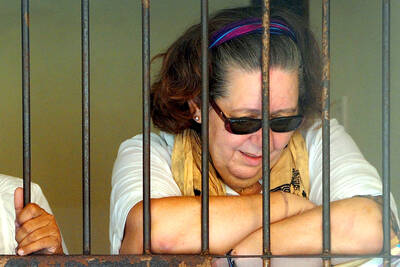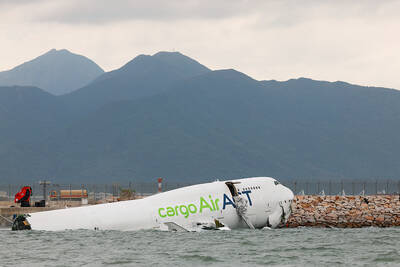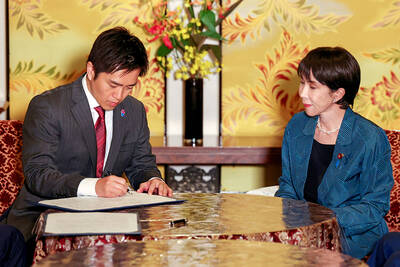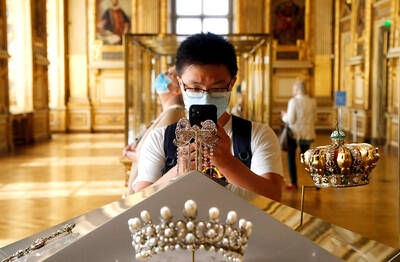For James Bond, spying was an endless succession of glamorous women and dry martinis, but for a real-life South Korean commando who undertook secret missions in the reclusive North, life was far harder.
Now aged 59 and the father of three daughters, Yoon Kyung-chul spends his days fixing up old bicycles for a charity in downtown Seoul, the South Korean capital.
That is a far cry from the day in 1973 when the 21-year old Yoon was summoned for duty to go and infiltrate North Korea, which is still technically at war with the South.

Photo: reuters
“It was 4am and three men in black suits came to my house. I didn’t have [a] chance to say a goodbye to my family,” Yoon said of the day he was recruited for the South’s Headquarters of Intelligence Detachment.
It wasn’t an official conscription. Yoon wound up on an isolated mountain without a name tag or badge of rank.
Yoon said many of the men in his new unit were enticed by the 30 million Korean won (US$25,148 at today’s exchange rate) on offer to join.
The 21-year old was trained in demolition, long-distance hiking, shooting and knife-hurling under tough conditions that included beatings for poor performance.
“There was no leave. For more than six months in a year, dressed in North Korean army uniforms, we were trained. Many people died during the training and many were injured,” he said.
Although overt hostilities between North and South Korea were stopped with a 1953 armistice, both sides conducted low-level hostilities.
About 13,000 men were trained like Yoon through to the early 1990s and more than 7,000 who worked until the early 1970s have been listed as missing or dead, according to government data. Several hundred of them are believed to be in the North.
When Yoon left the special forces in 1976 after three years’ service, he found he could not get a job and, even worse, that his own country was monitoring his activities.
“I was neither a civilian nor a soldier,” he said.
A protest movement by the former military agents saw rioting in Seoul in 2002 when several hundred of them set fire to gas canisters, eventually winning compensation and government recognition of their work.
Even so, many people still consider the ex-servicemen to be gangsters or extremists and nicknamed them “canister men.”
They still attend protests and the adverse public reaction prompted Yoon and another ex-commando to open a free bicycle repair center, donating the cycles to schools and daycare centers.
Beneath a sign on the wall of his workshop saying “What have I done for the Motherland today?” Yoon and his staff labor on.
“We said to ourselves, let’s not use our fists anymore ... Then, we picked up bicycles on streets. Our goal is to donate 600 bicycles next year,” he said. “I need to get rid of my dark past and show something better to my daughters.”

Indonesia was to sign an agreement to repatriate two British nationals, including a grandmother languishing on death row for drug-related crimes, an Indonesian government source said yesterday. “The practical arrangement will be signed today. The transfer will be done immediately after the technical side of the transfer is agreed,” the source said, identifying Lindsay Sandiford and 35-year-old Shahab Shahabadi as the people being transferred. Sandiford, a grandmother, was sentenced to death on the island of Bali in 2013 after she was convicted of trafficking drugs. Customs officers found cocaine worth an estimated US$2.14 million hidden in a false bottom in Sandiford’s suitcase when

CAUSE UNKNOWN: Weather and runway conditions were suitable for flight operations at the time of the accident, and no distress signal was sent, authorities said A cargo aircraft skidded off the runway into the sea at Hong Kong International Airport early yesterday, killing two ground crew in a patrol car, in one of the worst accidents in the airport’s 27-year history. The incident occurred at about 3:50am, when the plane is suspected to have lost control upon landing, veering off the runway and crashing through a fence, the Airport Authority Hong Kong said. The jet hit a security patrol car on the perimeter road outside the runway zone, which then fell into the water, it said in a statement. The four crew members on the plane, which

Japan’s ruling Liberal Democratic Party (LDP) and its junior partner yesterday signed a coalition deal, paving the way for Sanae Takaichi to become the nation’s first female prime minister. The 11th-hour agreement with the Japan Innovation Party (JIP) came just a day before the lower house was due to vote on Takaichi’s appointment as the fifth prime minister in as many years. If she wins, she will take office the same day. “I’m very much looking forward to working with you on efforts to make Japan’s economy stronger, and to reshape Japan as a country that can be responsible for future generations,”

SEVEN-MINUTE HEIST: The masked thieves stole nine pieces of 19th-century jewelry, including a crown, which they dropped and damaged as they made their escape The hunt was on yesterday for the band of thieves who stole eight priceless royal pieces of jewelry from the Louvre Museum in the heart of Paris in broad daylight. Officials said a team of 60 investigators was working on the theory that the raid was planned and executed by an organized crime group. The heist reignited a row over a lack of security in France’s museums, with French Minister of Justice yesterday admitting to security flaws in protecting the Louvre. “What is certain is that we have failed, since people were able to park a furniture hoist in the middle of